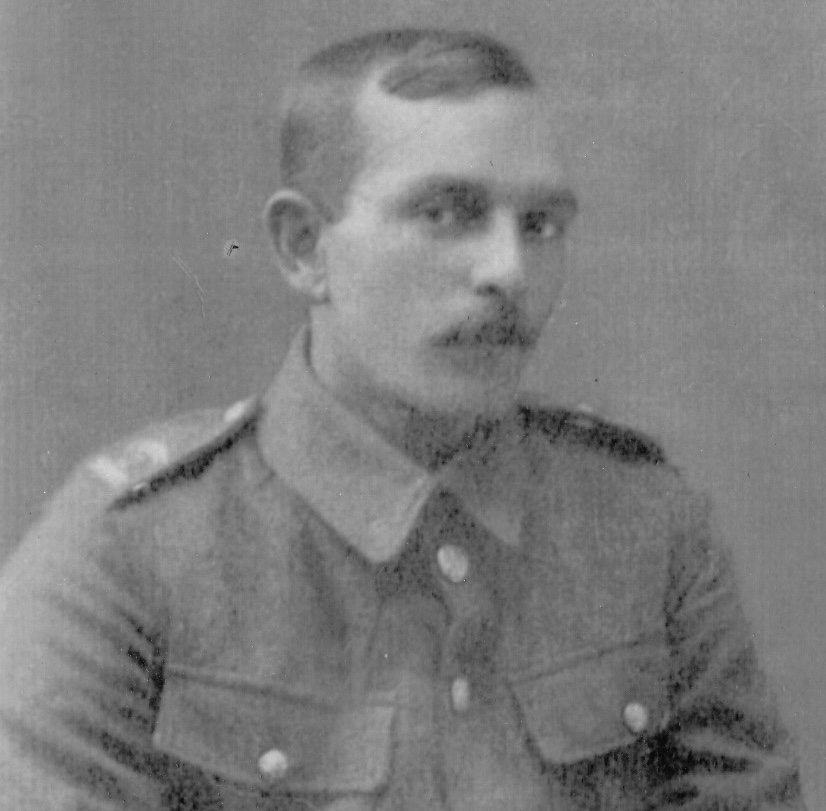Pte
Charles Frederick Harm
Information about birth
|
Year of birth: 1887 |
|
Place of birth: Whickham, Durham, England, United Kingdom |
General information
|
Last known residence: 1 South View Terrace, Whaggs Lane, Whickham, England, United Kingdom |
|
Profession: Coal miner |
Army information
|
Country: England, United Kingdom |
|
Force: British Expeditionary Force |
|
Rank: Private |
|
Service number: 22/86 |
|
Enlistment place: Newcastle upon Tyne, Northumberland, England, United Kingdom |
|
Units: — Northumberland Fusiliers, 10th Bn. (Last known unit) — Northumberland Fusiliers, 22nd Bn. (3rd Tyneside Scottish) |
Information about death
|
Date of death: 14/10/1917 |
|
Place of death: Reutel, Beselare, Belgium |
|
Cause of death: Killed in action (K.I.A.) |
|
Age: 30 |
Memorial
|
Tyne Cot Memorial Panel: 21 |
Distinctions and medals 2
|
British War Medal Medal |
|
Victory Medal Medal |
Points of interest 4
| #1 | Place of birth | ||
| #2 | Last known residence | ||
| #3 | Enlistment place | ||
| #4 | Place of death (approximate) |
My story
Charles Frederick Harm (in some documents Harme), was born in Whickham, Durham, England, in 1887. In 1906, he married Sarah Jane Jamison and earned a living as a miner. They had three daughters, Grace Alice, Sussanah and Hilda May.
In 1915, Charles enlisted in Newcastle upon Tyne. He was assigned to the 22nd Battalion Northumberland Fusiliers (3rd Tyneside Scottish), part of the 102nd Brigade of the 34th Division. He was later transferred to the 10th Battalion Northumberland Fusiliers, part of the 68th Brigade of the 23rd Division.
On 8 October 1917, the 23rd Division received orders to relieve the 7th Division on the Polygon Wood front. The division's front line ran from the Reutel Brook, west of Beselare, northwards to the Broodseinde - Beselare road, 1 mile away. The relief was completed on the night of 10-11 October. The 10th Battalion Northumberland Fusiliers took up position at Judge Copse, opposite upper Beselare between Judge cottage and the hamlet of Reutel. The ground was in a terrible state. Rain and incessant shelling had turned it into a swamp, which was still difficult to move through. The terrain near Reutel was littered with shell holes, surrounded by war debris, and filled with slimy water that could not hide the bodies of men and mules who could not be retrieved from the battlefield. Sometimes men would sink so deep and fast into the mud that it took almost an hour for their comrades to drag them out. German shelling with all calibres of shells, gas and incendiary bombs in the Reutel sector was constant, both by artillery and aircraft. Even the areas behind were not safe. On the night of 13-14 October, the 10th Battalion was relieved and sent to the Railway Dugouts near Zillebeke. One section remained behind at Joist Farm.
Private Charles Frederick Harm was 30 years old when he fell on 14 October 1917. He has no known grave but his name is commemorated on the Tyne Cot Memorial, panel 21.
In 1915, Charles enlisted in Newcastle upon Tyne. He was assigned to the 22nd Battalion Northumberland Fusiliers (3rd Tyneside Scottish), part of the 102nd Brigade of the 34th Division. He was later transferred to the 10th Battalion Northumberland Fusiliers, part of the 68th Brigade of the 23rd Division.
On 8 October 1917, the 23rd Division received orders to relieve the 7th Division on the Polygon Wood front. The division's front line ran from the Reutel Brook, west of Beselare, northwards to the Broodseinde - Beselare road, 1 mile away. The relief was completed on the night of 10-11 October. The 10th Battalion Northumberland Fusiliers took up position at Judge Copse, opposite upper Beselare between Judge cottage and the hamlet of Reutel. The ground was in a terrible state. Rain and incessant shelling had turned it into a swamp, which was still difficult to move through. The terrain near Reutel was littered with shell holes, surrounded by war debris, and filled with slimy water that could not hide the bodies of men and mules who could not be retrieved from the battlefield. Sometimes men would sink so deep and fast into the mud that it took almost an hour for their comrades to drag them out. German shelling with all calibres of shells, gas and incendiary bombs in the Reutel sector was constant, both by artillery and aircraft. Even the areas behind were not safe. On the night of 13-14 October, the 10th Battalion was relieved and sent to the Railway Dugouts near Zillebeke. One section remained behind at Joist Farm.
Private Charles Frederick Harm was 30 years old when he fell on 14 October 1917. He has no known grave but his name is commemorated on the Tyne Cot Memorial, panel 21.
Sources 5
|
10 Nothumberland Fusiliers (The National Archives, Kew (TNA) WO 95/2182/3). https://www.nationalarchives.gov.uk/ Sources used |
|
British Army World War I Medal Rolls Index Cards, 1914-1920 (The National Archives, Kew (TNA), WO 372). https://www.nationalarchives.gov.uk/ Sources used |
|
Census Returns of England and Wales, 1911 (The National Archives, Kew (TNA), RG14). https://www.nationalarchives.gov.uk/ Sources used |
|
Sandilands H.R., The 23rd Division 1914-1919., (Edinburgh and London, William Blackwood and Sons, 1925), 206-209. Sources used |
|
UK, World War I Service Medal and Awards Rolls, 1914-1920(The National Archives, Kew (TNA), WO 329). https://www.nationalarchives.gov.uk/ Sources used |
More information 3
|
Commonwealth War Graves Commission Database https://www.cwgc.org/find-records/find-war-dead/casualty-details/838523 |
|
Lives of the First World War (Imperial War Museum) https://livesofthefirstworldwar.iwm.org.uk/lifestory/1564762 |
|
Namenlijst (In Flanders Fields Museum) https://namenlijst.org/publicsearch/#/person/_id=53085f94-d707-4241-9f73-962543d0cd1e |
